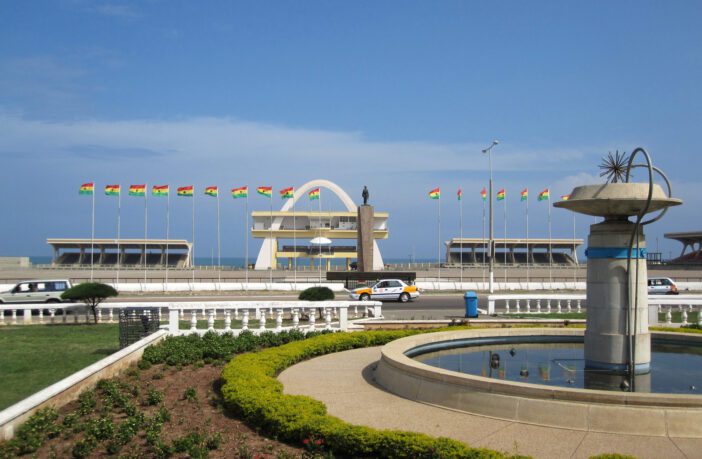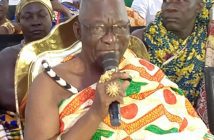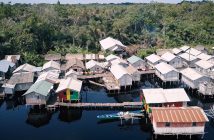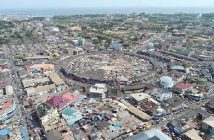The Black Star Square, also known as the Independence Square, is a public square in Accra, Ghana bordered by the Accra Sports Stadium and the Kwame Nkrumah Memorial Park.
The square which is often used as a venue to host the annual independence celebrations as well as other national events was commissioned by the late Dr. Kwame Nkrumah to celebrate the nations independence.
The Republic of Ghana which is named after the medieval West African Ghana Empire became known in Europe and Arabia as the Ghana Empire after the title of its Emperor. Geographically, the ancient Ghana Empire was approximately 500 miles (800 km) north and west of the modern state of Ghana, and controlled territories in the area of the Sénégal River and east towards the Niger rivers, in modern Senegal, Mauritania and Mali.
Central Sub-Saharan Africa, agricultural expansion marked the period before 500 AD. Farming began earliest on the southern tips of the Sahara, eventually giving rise to village settlements. Toward the end of the classical era, larger regional kingdoms had formed in West Africa, one of which was the Kingdom of Ghana, north of what is today the nation of Ghana.
Before its fall at the beginning of the 10th century Akans migrated southward and founded several nation-states around their matriclans, including the first empire of Bono State founded in the 11th century and for which the Brong-Ahafo (Bono Ahafo) region is named.
Later Akan ethnic groups such as the Ashanti empire-kingdom, Akwamu, Akyem, Fante state and others are thought to possibly have roots in the original Bono State settlement at Bono Manso.The Ashanti kingdom’s government operated first as a loose network and eventually as a centralized empire-kingdom with an advanced, highly specialized bureaucracy centred on the capital Kumasi.
In 1945 a Conference (known as the 5th Pan-African Congress) was held in Manchester to promote Pan-African ideas. This was attended by Doctor Nkrumah of Ghana, Nnamdi Azikiwe of Nigeria and I. T. A. Wallace-Johnson of Sierra Leone. The Indian and Pakistani independence catalysed this desire. There was also the rejection of African culture to some extent. Some external forces also contributed to this feeling. African-Americans such as W. E. B. Du Bois and Marcus Garvey (Afro-Jamaican) raised strong Pan-African conscience.
Sir Alan Burns constitution of 1946 provided new legislative council that was made of the Governor as the President, 6 government officials, 6 nominated members and 18 elected members. The executive council was not responsible to the legislative council. They were only in advisory capacity, and the governor did not have to take notice.
These forces made Dr J. B. Danquah form the United Gold Coast Conversion (UGCC) in 1947, and Nkrumah was invited to be this party’s General Secretary. Other officers were George Alfred Grant (Paa Grant), Edward Akufo-Addo, William Ofori Atta, Emmanuel Obetsebi-Lamptey, Ebenezer Ako-Adjei, and J. Tsiboe.
Their aim was Independence for Ghana. They rejected the Burns constitution amendment of a number of its clauses. It also granted a voice to chiefs and their tribal councils by providing for the creation of regional assemblies. No bill amending the entrenched clauses of the constitution or affecting the powers of the regional bodies or the privileges of the chiefs could become law except by a two-thirds vote of the National Assembly and by simple majority approval in two-thirds of the regional assemblies.[169] When local CPP supporters gained control of enough regional assemblies, however, the Nkrumah government promptly secured passage of an act removing the special entrenchment protection clause in the constitution, a step that left the National Assembly with the power to effect any constitutional change the CPP deemed necessary.
The electoral victory of the CCP in 1951 ushered in five years of power-sharing with the British. The economy prospered, with a high global demand and rising prices for cocoa. The efficiency of the Cocoa Marketing Board enabled the large profits to be spent on development of the infrastructure. There was a major expansion of schooling and modernizing projects such as the new industrial city at Tema. Favored projects by Nkrumah included new organizations such as the Young Pioneers, for young people, and the Builder’s Brigades for mechanization of agriculture. There were uniforms, parades, new patriotic songs, and the presentation of an ideal citizenship in which all citizens learned that there their primary duty was to the state.
On August 3, 1956, the new assembly passed a motion authorizing the government to request independence within the British Commonwealth. The opposition did not attend the debate, and the vote was unanimous. The British government accepted this motion as clearly representing a reasonable majority, so on 18 September 1956 the British set 6 March 1957, the 113th anniversary of the Bond of 1844, as the date that the Gold Coast, Ashanti, the Northern Territories and British Togoland would together become a unified, independent dominion within the British Commonwealth of Nations under the name Ghana. Nkrumah continued as prime minister, and Queen Elizabeth II as monarch, represented in the dominion by the Governor-General of Ghana, Sir Charles Noble Arden-Clarke. Dominion status would continue until 1960, when after a national referendum, Ghana was declared a Republic.
The Second Development Plan of 1959-1964 followed the Soviet model, and shifted away from expanding state services toward raising productivity in the key sectors. Nkrumah believe that colonialism had twisted personalities, imposing a competitive, individualistic and bourgeois mentality that had to be eliminated.
Worldwide cocoa prices began to fall, budgets were cut, and workers were called upon for more and more self sacrifice to overcome neocolonialism. Nkrumah rapidly shortened the independence of the labor unions, and when strikes resulted he cracked down through the Preventive Detention Act. On the domestic front, Nkrumah believed that rapid modernization of industries and communications was necessary and that it could be achieved if the workforce were completely Africanized and educated. Expansion of secondary schools became a high priority in 1959–1964, along with expansion of vocational programs and higher education.
In 1957, Kwame Nkrumah became the first prime minister and president of Gold Coast, now Ghana after gaining independence from the British. The commission of the black star square, coincided with the visit of Queen Elizabeth II.
Black Star Square is a site for Ghana’s Independence Day parade, which falls on the 6th of March every year. The Independence Square which is the second largest town square in the world after the Tiananmen Square in Beijing, China, held a particularly notable parade called the Golden Jubilee, which was Ghana’s 50th anniversary of independence from British colonial rule. The Golden Jubilee celebration occurred on March 6, 2007 and it was led by President John Kuffour. It also hosts all major national public gatherings and national festivals. Every visitor is free to take pictures of buildings, including the Black Star Gate. At the square, one can sight the independence Arch, the liberation day Monument and the black star gate, which epitomizes the fight for independent and liberation.
There are stands at the square that can seat 30,000 people. A statue of a soldier facing the Independence Arch symbolizes the Ghanaians who lost their lives fighting for Ghana’s independence. As of 2011, the Independence Arch was guarded by several soldiers who prevented people of taking close up pictures of the Arch and asking visitors for official permission, but you are free to take pictures of the area.
Liberation Day monument is a monument that stands in honor of several veterans of the Burma campaign conducted during the Second World War by commonwealth forces in which the veterans fought for the British Empire. After returning to Ghana, some of the veterans began a peaceful protest and marched towards Christiansborg Castle. The protesters were fired upon, and seven of the veterans were killed.
On March 24, 1998, over 500,000 people gathered at the square to welcome former U.S. President Bill Clinton and his wife, Hillary Clinton. This event marked the first U.S. president to visit Ghana.
REFERENCES
1. Available online at, https://en.m.wikipedia.org/wiki/Independence_Arch
2. Available online at, https://en.m.wikipedia.org/wiki/Liberation_Day_Monument.
3. Available online at, https://en.m.wikipedia.org/wiki/Black_Star_Square.
4. Available online at, https://en.m.wikipedia.org/wiki/History_of_Ghana





